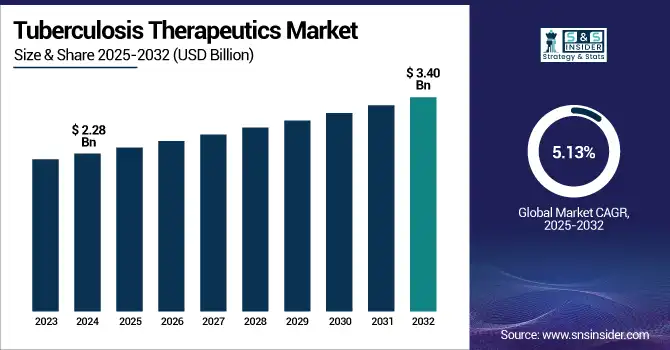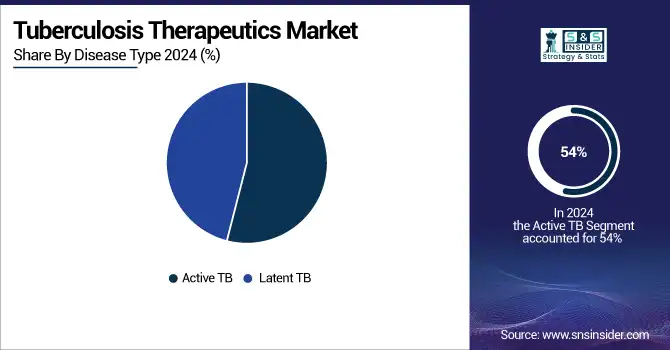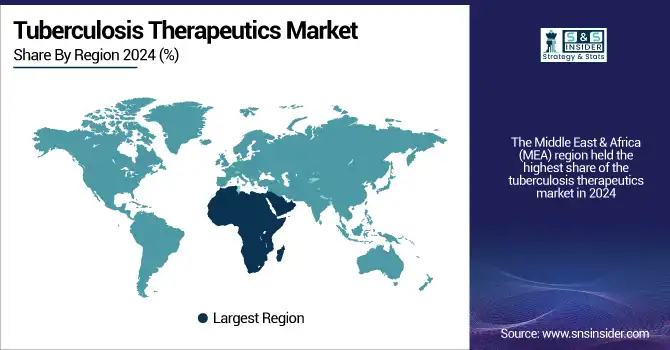Tuberculosis Therapeutics Market Size Analysis:
The Tuberculosis Therapeutics Market size was valued at USD 2.28 billion in 2024 and is expected to reach USD 3.40 billion by 2032, growing at a CAGR of 5.13% over the forecast period of 2025-2032.

To Get more information on Tuberculosis Therapeutics Market - Request Free Sample Report
The tuberculosis therapeutics market is witnessing profound development driven by mounting TB drug resistance, enhanced global awareness, and supportive regulatory environments. According to WHO estimates, the growing number of multidrug-resistant tuberculosis (MDR-TB) cases was approximately 410,000 cases globally in 2021, which has increased the need for novel and potent anti-tuberculosis drugs. Existing first-line TB drugs, such as rifampin and isoniazid, are becoming less effective, thus necessitating increased research into second-line drugs for tuberculosis and new TB therapeutics. The global anti-tuberculosis therapeutics market is greatly aided by significant investment.
For instance, the U.S. government spent around USD 394 million on global TB programs in FY2022, including the U.S. tuberculosis therapeutics market and foreign research and development. The tuberculosis drug pipeline is expanding, as evidenced by the FDA's regulatory approval of pretomanid via the Limited Population Pathway.
For instance, NEJM (2024) released findings from a clinical trial indicating that a four-month treatment of rifapentine and moxifloxacin performs well for drug-susceptible tuberculosis, providing a shorter and equally effective alternative to the standard six-month treatment-influencing future patterns in the tuberculosis therapeutics market.
Moreover, leadership in clinical trials and financial backing from organizations, such as The Global Fund and the CDC continue to advance tuberculosis medication innovation, alongside strong support for the ocular tuberculosis therapeutics market. The tuberculosis treatment sector is driven by rising demand for diagnostics, substantial research and development costs, and enhanced regulatory approvals and guidelines, particularly the 2025 CDC guidelines. The development of supply chain capabilities, the rise of new tuberculosis therapeutics companies, and a shift toward customized treatment regimens are expected to significantly impact the tuberculosis therapeutics market growth. Therefore, the tuberculosis therapeutics market share is expected to be highly competitive in different regions.
In April 2025, TB Alliance and GSK launched a new anti-TB drug of the oxazolidinone class acting against second-line resistant strains and carried out a detailed tuberculosis therapeutics market analysis of the tuberculosis therapeutics market trends, along with an enhancement of tuberculosis treatment drugs by stimulating innovation.
Global Tuberculosis Therapeutics Market Dynamics:
Drivers:
-
The heightened international priority on universal health care and infectious disease readiness in the aftermath of the COVID-19 pandemic.
One of the major drivers in the global tuberculosis therapeutics market is the heightened international priority on universal health care and infectious disease readiness in the aftermath of the COVID-19 pandemic. The 194 nations have committed to cutting tuberculosis deaths by 90% by 2035, consistent with the WHO End TB Strategy, which placed policy interventions on a top priority agenda. Moreover, significant investment in early diagnosis and implementation of treatment is improving early detection and utilization of anti-tuberculosis drugs.
The use of decentralized treatment programs and community-based DOT in nations, such as India and South Africa optimized drug adherence, particularly for first-line tuberculosis medication. Integration of tuberculosis services with HIV programs is a new phenomenon, advocated by global organizations, such as PEPFAR and the Global Fund. Long-acting injectables and nanotechnology-mediated drug-delivery systems are revolutionizing tuberculosis care. Leading the line are pharma collaborations, such as the TB Alliance collaborations with Otsuka and Johnson & Johnson. Impetus including Orphan Drug Status and the FDA's limited population route for antibacterial and antifungal medication designation encourages funding in innovative second-line tuberculosis drug development. This advancement allows examination of tuberculosis medication to advance considerably, thus laying it for continued scientific and financial development.
Restraints:
-
Unique Structural and Socio-Economic Challenges Limit the Growth and Efficiency of the Tuberculosis Therapeutics Market
One of the major challenges experienced by the tuberculosis drugs industry is inequality in access to recently licensed drugs. Despite regulatory approval of better regimens, such as substitutes for rifampin and isoniazid, availability is limited by high prices and inadequate technology transfer. Patent limitations and intellectual property rights can prohibit low- and middle-income countries from accessing generic options. A key issue is the lack of tuberculosis drug firm funding compared to other disease areas, and less than 2% of total infectious disease research and development spending is devoted to TB.
Healthcare delivery systems in high-burden countries often lack cold chain spaces for the refrigeration of temperature-sensitive storage of new tuberculosis medicines. In addition, weak pharmacovigilance systems hinder the early detection of adverse drug reactions, especially among HIV co-infected patients. Misdiagnosis of extrapulmonary and ocular tuberculosis prevents targeted treatment due to weak diagnostic equipment and practitioner skills. Delayed regulation, especially in countries with ineffective approval processes, prevents early availability of second-line tuberculosis drugs.
Tuberculosis Therapeutics Market Segmentation Insights:
By Disease Type
Active TB led the tuberculosis therapeutics market in 2024 with a 54% share due to the high number of global active infectious cases, which need to be treated urgently. The segment's dominance is driven by the effective government-initiated public health campaigns and WHO-supported DOTS programs intended to fight TB's infectious nature. With more than 10 million active TB cases reported annually, significant demand for speedy curative intervention involving first- and second-line TB drugs remains.
Latent TB is expected to be the most rapidly expanding segment during the forecast period as health systems increasingly adopt screening and preventive treatment interventions to prevent TB transmission at an earlier stage, latent TB will be the most rapidly expanding sector. Lower treatment regimens, such as the 3-month isoniazid-rifapentine regimen, and increased funding by organizations, such as the CDC and the Global Fund have facilitated the scaling up of preventative therapy. These developments are heightening demand from at-risk but asymptomatic people globally for anti-tuberculosis drugs.

By Therapeutics Therapy
The first-line therapy segment held the largest share of 65.3% in 2024, where the majority of TB cases, particularly drug-sensitive, along with ethambutol and pyrazinamide, which are first treated with combined rifampin and isoniazid. WHO and CDC recommend these fairly inexpensive, universally accessible drugs as the treatment standard. Their common availability in national TB programs and conformity with free public healthcare systems have ensured their success.
The growing incidence of multidrug-resistant tuberculosis (MDR-TB) and extensively drug-resistant tuberculosis (XDR-TB) is propelling the second-line therapy segment is anticipated to be the market's fastest-growing. More recently introduced agents including bedaquiline, delamanid, and pretomanid, which are increasingly used for resistant TB, have been ushered in by increased drug discovery budgets. Their usage was significantly boosted by the WHO's addition of these drugs to newer, shorter MDR-TB regimens and approvals across highly burdened countries. Their increasing use is likely to shape TB therapeutics in the future.
By Route of Administration
The oral segment of the route of administration held a robust 77.8% market share in 2024. Its ease, cost-effectiveness, and good patient compliance made it especially suitable for the 6-month duration necessary in standard TB therapeutics. Fixed dose combinations of first-line anti-TB drugs, and other oral anti-tuberculosis drugs, have been optimized for application in adult and pediatric age groups. Tablets and capsules also allow for distributed treatment, thereby facilitating telemedicine-based follow-up and community-based DOT schemes.
Parenteral is anticipated to grow at the highest rate among the categories. Injectable drugs play a crucial role in MDR-TB patients who require more potent and more rapid-emerging TB treatments, particularly in hospital settings, where speedy absorption and exact dosing are required, such that intramuscular or intravenous administration becomes inevitable. The demand for injectable forms will increase at a high rate for complex and drug-resistant cases, with the introduction of new long-lasting injections and very small formulations to tuberculosis treatment.
By Dosage Form
The tablet segment dominated the tuberculosis treatment market in 2024, primarily due to the fixed-dose combination tablets. Which are utilized in first-line therapy. Due to their stability, ease of use, shelf life, and easier dose regimens, tablets are the dosage form of choice in public health programs. Most importantly, in prolonged tuberculosis therapy, they are ideal for patient compliance and self-administration. In addition, global initiatives, such as the Stop TB Partnership's Global Drug Facility ensure a continuous supply of TB pills in high-burden countries at an affordable price.
The injectable segment is expected to be the most rapidly growing, fueled by the growing need for parenterally administered second-line TB drugs in hospital settings. Injectable drugs commonly employed for MDR-TB, especially when oral therapy is not sufficient, include amikacin, capreomycin, and newer drugs, such as bedaquiline. In this area of TB treatment, the development of new injectables and targeted drug delivery systems is expected to spur further innovation.
By Distribution Channel
Hospital pharmacy accounted for the largest share of the tuberculosis therapeutics market in 2024 due to the centralized nature of the TB treatment protocol used in most low- and middle-income countries. Especially in the cases of active and MDR-TB, where treatment needs to be monitored, government hospitals and national TB programs dispense the majority of anti-tuberculosis drugs. For highly effective second-line tuberculosis drugs and newly approved TB drugs, hospital settings also facilitate monitoring of adverse drug reactions.
Retail pharmacy is likely to witness the most rapid growth in the forecast period on the back of the proliferation of distributed therapy and rising latent TB diagnosis. Especially for continuation phase patients or patients with ocular tuberculosis and non-infectious cases, retail pharmacies are increasingly becoming significant points of care. The increasing role of retail outlets in the global distribution of emerging TB treatments is motivated by improved access, growing health consciousness, and involvement of the private sector.
Regional Overview:
The Middle East & Africa (MEA) region held the highest share of the tuberculosis therapeutics market in 2024 and will continue to lead during the forecast period. The huge burden of the demand for tuberculosis treatment in countries with high frequency, weak healthcare infrastructure, and ongoing regional initiatives supported by the WHO and Global Fund accounts for the dominance. With approximately 328,000 new cases reported annually, tuberculosis remains the leading cause of death in South Africa. The country places first-line TB drugs scaling top on its agenda, along with second-line treatment availability for drug-resistant strains.
Asia Pacific is expected to witness the highest growth in the tuberculosis treatment market during the forecast period, benefiting from a combination of high disease prevalence, increasing healthcare spending, and government-sponsored eradication efforts. India, with more than 27% of global TB cases, is at the forefront of the region with strong national programs, such as the National TB Elimination Program (NTEP), which allows for mass screening, free anti-tuberculosis drugs, and new treatment regimens. Improvements in diagnostic technology and government-funded second-line TB drug supply are assisting in the containment of drug-resistant TB strains in China.
North America is a prominent region in the tuberculosis therapeutics market, largely driven by well-established health infrastructure and increasing emphasis on eliminating latent TB. Strong surveillance systems, CDC guidelines, and investments of over USD 394 million annually in domestic and foreign tuberculosis control programs enable the U.S. to lead the field. Accelerated access to advanced medicines is facilitated by recent revisions in the CDC's 2025 treatment guidelines and more rapid FDA approval of new anti-tuberculosis drugs. The U.S. tuberculosis therapeutics market size was valued at USD 0.12 billion in 2024 and is expected to reach USD 0.15 billion by 2032, growing at a CAGR of 2.92% over the forecast period of 2025-2032. Canada is highly active, especially in immigrant and Indigenous TB, with community outreach and reduced program lengths.

Get Customized Report as per Your Business Requirement - Enquiry Now
Tuberculosis Therapeutics Market Key Players
The leading players operating in the market are Johnson & Johnson Services, Inc., AstraZeneca, Eli Lilly and Company, Viatris Inc. (Mylan N.V.), Teva Pharmaceutical Industries Ltd., Sanofi, Novartis AG, Sun Pharmaceutical Industries Ltd., Pfizer Inc., and Macleods Pharmaceuticals Ltd.
Recent Developments:
-
In Nov 2024, Macleods Pharmaceuticals Ltd. received prequalification from the World Health Organization (WHO) for its 200mg tablet of pretomanid, assuring safety, quality, and efficacy for drug-resistant tuberculosis patients.
-
In July 2024, Johnson & Johnson received full approval from the U.S. FDA and European Commission for SIRTURO (bedaquiline) to treat pulmonary multidrug-resistant tuberculosis (MDR-TB) in adults and children aged five years and older.
| Report Attributes | Details |
|---|---|
| Market Size in 2024 | USD 2.28 Billion |
| Market Size by 2032 | USD 3.40 Billion |
| CAGR | CAGR of 5.13% From 2025 to 2032 |
| Base Year | 2024 |
| Forecast Period | 2025-2032 |
| Historical Data | 2021-2023 |
| Report Scope & Coverage | Market Size, Segments Analysis, Competitive Landscape, Regional Analysis, DROC & SWOT Analysis, Forecast Outlook |
| Key Segments | • By Disease Type (Active TB, Latent TB) • By Therapeutics Therapy (First-Line Therapy, Second-Line Therapy) • By Route of Administration (Oral, Parenteral, and Others) • By Dosage Form (Tablets, Capsules, Injection, and Others) • By Distribution Channel (Hospital Pharmacy, Retail Pharmacy, and Online Pharmacy) |
| Regional Analysis/Coverage | North America (US, Canada, Mexico), Europe (Germany, France, UK, Italy, Spain, Poland, Turkey, Rest of Europe), Asia Pacific (China, India, Japan, South Korea, Singapore, Australia, Rest of Asia Pacific), Middle East & Africa (UAE, Saudi Arabia, Qatar, South Africa, Rest of Middle East & Africa), Latin America (Brazil, Argentina, Rest of Latin America) |
| Company Profiles | Johnson & Johnson Services, Inc., AstraZeneca, Eli Lilly and Company, Viatris Inc. (Mylan N.V.), Teva Pharmaceutical Industries Ltd., Sanofi, Novartis AG, Sun Pharmaceutical Industries Ltd., Pfizer Inc., and Macleods Pharmaceuticals Ltd. |

